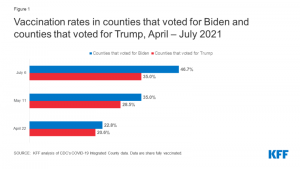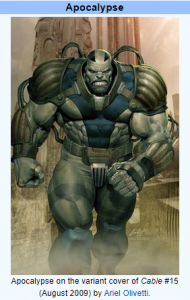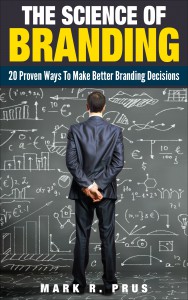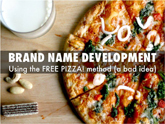Branding
Take The Trump Vaccine!
The Delta variant of COVID is spreading like wildfire in the US and is having a devastating effect on the unvaccinated. At the present time, 99% of COVID deaths are among unvaccinated people. In fact, a recent Washington Post opinion piece estimated that the odds of dying from COVID if you have been vaccinated are lower than the odds of dying by getting hit by lightning.
Yet only about 50% of people in the US are fully vaccinated and the rate of new vaccinations is slowing down dramatically. Furthermore, there is a widening divide of vaccination rates between Democratic voters and Republican voters as shown below:
Sarah Sanders, former White House Press Secretary and current candidate for Governor of Arkansas, may have identified a novel way to nudge Republicans to get vaccinated. In this Washington Post article she urges Republicans to “Take The Trump Vaccine.”
Here is how it could work. The Moderna and J & J vaccines were developed under the Operation Warp Speed initiative created by the Trump Administration. The Pfizer vaccine was not in the Operation Warp Speed program. In order to overcome vaccine hesitancy among Republicans, the government should rebrand some of the Moderna and J & J vaccines as Trump Vaccine and offer it exclusively to Republicans. Everyone likes to have exclusive products, and a vaccine just for Trump supporters could get vaccine hesitant people to roll up their sleeves.
Branding can help save lives.
Domain Considerations vs Strategic Name Development
I have been approached numerous times about developing a name “…with a .com domain available and no more than 6 letters” or something like that.
Limiting the number of letters and requiring a .com domain means you will end up with a random letter name/domain such as ksnhent.com (which is available!).
Clients who insist on making domain availability the primary reason for choosing a name are making a huge mistake.
A far better approach is to hone your brand’s strategy and test it with consumers until you find the positioning that is going to make all the difference in your business, then develop a name based on that positioning.
David Ogilvy once said “The results of your campaign depend less on how we write your advertising than on how your product is positioned.” The same is true for your name. Spend time developing a positioning that rings the bell with consumers and then go find the perfect name that brings that positioning to life.
Sound like a difficult thing to do? Not really. I know I am biased by my 25+ years of experience in building great consumer brands, but this task is not difficult. Time consuming? Yes. At times painful? Yes. Expensive? Could be. But in the end, the process of honing the brand positioning and using that as a basis for name development will pay dividends for years to come.
The one downside is, it is unlikely that a name based on a strategic foundation will have a short .com domain available. However, you can add modifiers to the beginning or end of the name to get a .com domain.
Here is an example. Let’s say you have developed a strategically based name of “Regal” for your brand name. Of course, www.regal.com is already taken. But here are a few ideas for domains that are available for a minimal cost:
HeyRegal.com
BestRegal.com
RegalQuick.com
RegalForever.com
RegalAllDay.com
RegalCalling.com
RegalEtc.com
HelloRegal.com
RegalForAll.com
Marketing Euphemisms – Clean Wine
eu·phe·mism
/ˈyo͞ofəˌmizəm/
noun
a mild or indirect word or expression substituted for one considered to be too harsh or blunt when referring to something unpleasant or embarrassing.
We all know a euphemism when we see it (e.g., being downsized instead of being fired; a correctional facility instead of a jail).
Sometimes marketers get a bit carried away in creating euphemisms to enhance their story. For example, consider the term “clean wine.” The Wonderful Wine Co. is trying to latch onto the “clean diet” trend by calling their wine “clean wine.” Here is how they define a “clean wine”:
• PESTICIDE-FREE
• VEGAN
• LOW CARB
• LOW SUGAR
• PALEO
• KETO
• LOW SULFITE
• SUSTAINABLY-FARMED
• ORGANIC GRAPES (Grapes are certified organic by the CCOF whenever possible)
We’ve had wines produced in sustainable fashion using organic grapes that meets these attributes for a while now, so clearly “clean wine” is a marketing euphemism that lacks uniqueness.
Furthermore, they advertise that their wine tastes like:
• TASTES LIKE DOLPHIN RIDES AND BEING PROMOTED TO HEAD ASTRONAUT
• TASTES LIKE SHOOTING STARS, LONG NAPS, AND FINDING TWENTY BUCKS
• TASTES LIKE MAGIC HOUR, BEING RIGHT, AND BEATING THE HIGH SCORE
Trying too hard to sound trendy? I think so.
Hurricane Names
Today I learned that, after Hurricane Sally, the next named hurricane will be named Teddy. Hurricane Teddy? And to make matters worse, the two after that will be named Hurricane Vicky and Hurricane Wilfred. Here is the official list of hurricane names. https://geology.com/hurricanes/hurricane-names.shtml
With all due respect to people named Teddy, Vicky and Wilfred, I don’t think those are appropriate names for a hurricane. If Hurricane Teddy ends up being a destructive hurricane, the name itself will prevent people from taking it seriously. Who is going to evacuate in the face of Hurricane Teddy?
I think hurricanes should be named after supervillains. If you head that Hurricane Apocalypse (Apocalypse was a fictional supervillain appearing in comic books published by Marvel Comics) was heading your way, I bet you would take that threat seriously.
But Hurricane Teddy? Hurricane Wilfred? I bet you’d take your chances and try to ride it out.
BACD = Pay Attention To Me
I recently purchased some bar stools from Wayfair. As many of you know, much of the furniture sold on Wayfair requires assembly, and these bar stools were no exception. As a proficient assembler of IKEA furniture, I figured I could handle it.
I started out by taking everything out of the box, and reading the assembly instructions. There were 4 legs, two marked A and two marked B (all 4 legs looked to be identical). There were four side supports, two marked C and two marked D. The seat was marked E.
I assumed that the first step in the instructions would involve the legs marked A, but I was wrong. The first step said to mount the legs marked B into the base E. Why start with the legs marked B? Was this just a bad translation of foreign language instructions?
I’ll give the designers more credit than that. In fact, they may have been leveraging a type of cognitive bias. Face it, when things go as you expect them to go, you pay less attention. However, when the instructions start with Leg B instead of Leg A, you read the instructions more closely.
This bias is also useful in name development. Entrepreneurs love descriptive names. A food processor that does a fast job of chopping up food gets named “Fast Chop.” Entrepreneurs think this makes life easier because they do not have to spend money to advertise the benefits of their product…the name says it all!
In reality, “Fast Chop” gets lost in a sea of competitive products with similar names (“Quick Chop” or “Turbo Chop”). To stand out you need a name that is different and causes the consumer to stop and notice. In other words, you often need to put the assembly instructions in BACD order!
Here is a visual way to demonstrate the issue. In the three groups of circles shown below, the circle in the center is always the same size. However, as you can see, the center circle looks smaller or larger based upon the size of the other circles surrounding it. The group of circles on the right has six similarly sized circles, and you can see how it is impossible to distinguish one from another. If you want to stand out, it is far better to be the outlier, such as the center circle in the first two groups of circles.
Tell Me A Story
Smart marketers know how to tell a story. One of Seth Godin’s early books, All Marketers Are Liars, explains the use of storytelling as a marketing tool. It is proven to work.
If you want to up the degree of difficulty, try cueing a story with your name. It is not an easy thing to do. But a good marketer should be able to use the product name as an entry into a story.
Here is an example of how one of our clients did that.
This client was importing a spice liqueur from Goa, India, to the US, and hired NameFlash to develop a name. The recipe for the liqueur is an old family recipe developed centuries ago in a remote village in central Portugal, and includes sugar from Brazil, spices from Asia, and Portuguese fruit, which are then all steeped in strong spirit until the liqueur matures. The resulting dark amber spirit has a unique taste all of its own – it opens with top notes of cardamom, cinnamon and orange, and you slowly get hints of turmeric, cloves and other spices as the taste lingers on the palate.
This liqueur is more complex than Fireball® (cinnamon whiskey) but given the rapid growth of Fireball® to a multimillion-dollar brand, it might have been tempting to develop a similar brand name. However, in working with the client, we developed a storyline that gave this product a unique home in the liqueur universe.
The diverse ingredients in the liqueur emerged from the global explorations of the Portuguese Empire which included the Spice Islands, Brazil, parts of Africa and Western India. Vasco da Gama, the Portuguese explorer, was the first European to reach India by sea. His initial voyage to India (1497–1499) was the first to link Europe and Asia by an ocean route, thereby establishing a new Spice Route to India’s southwestern coast. This part of India was known as the Malabar Coast, and as trade developed, it became one of the most powerful regions of India.
We recommended that the client name the product Malabar. Malabar is an exotic name that conjures up images of kingdoms ruled by maharajas, and the history of the Malabar Coast is aligned with the development of the recipe for this product. With a strong historical base and powerful imagery, we felt we had a winner. And the client has taken the name and further developed the story around the product on its website. The product has launched and is available in selected states (www.drinkmalabar.com).
The Perils of Portmanteau Names
A portmanteau is a linguistic blend of words in which parts of multiple words are combined into a new word. Common language examples include smog, which is a combination of the words smoke and fog, and motel which combines motor and hotel.
Some big companies used the portmanteau technique to develop their names. Microsoft is a portmanteau of microcomputer and software. Groupon combines group and coupon.
However, sometimes companies refuse to admit that their portmanteau name doesn’t work.
Consider this manufacturer of pool maintenance products.
Yes, I get that they slammed “pool” and “life” together to get their name, but no matter how many times you look at this name it is hard to not see “Poo Life” isn’t it? And who wants to live a “poo life” anyway?
Here is another one. Yes, I see what they did here by combining “smart” and “tours.” But step away from the page for a second and look at it…what the heck is a “smar Tour” (or did you mean “smarT ours)?
Portmanteau names can be very good when the combination makes sense. But you have to have some common sense (as in most things in life). Combining words together to make a brand name can work or can look very stupid. Don’t be stupid!
How Alexa Will Change The Way We Name Companies
I read an interesting post on the Inc. magazine site about how Amazon Alexa will change the way we name companies. While I wholeheartedly agree with the author, there are many more considerations in developing a great name.
My book 10 Steps To Successful Branding contains a simple 10 step checklist that enables you to determine if you have a great name. One of the items involves the pronunciation and spelling so Alexa can understand the name. But the nine other items on the list are also important.
If you want a pdf of the checklist let me know!
Why Is The Trump Brand Doing So Well?
Donald Trump is the leader in the race for the Republican nomination for President. A CNN/ORD national survey (conducted after his comments about John McCain) puts Donald Trump ahead with the support of 18% of Republicans, Jeb Bush at 15% and Scott Walker at 10%.
Why is the Trump brand doing so well?
Donald Trump is a celebrity and he has the highest name recognition of any of the candidates by far. A recent Gallup poll puts Trump’s name identification among Republicans at 92%. In fact, a poll by CNN found that only 1% of Americans had never heard of Donald Trump. Is his celebrity fame and name recognition driving his lead in the polls?
As a branding expert, I must say that celebrity fame and name recognition are certainly good. However, everyone has heard of Caitlyn (aka Bruce) Jenner and Kim Kardashian and you would not see them at the top of the polls if they were running for President. Clearly there is something more than just awareness.
I believe it is caused by Trump’s superior execution of a classic marketing technique: understanding your Target Audience. Trump knows he is not going to win over the politicos or the Washington Insiders. Instead, he speaks to the “common man.” His campaign features themes that the common man talks to his buddies about at the bar (but they never mention when they are in public). Trump has even branded this group as “the silent majority.” Trump is a smart marketer who understands his Target Audience!
For example, Trump constantly rails against the “Washington Insiders.” He says he’s fed up with Congress and is tired of “…being pushed around, kicked around, and acting and being led by stupid people.” Attacking the incumbents is often a good election strategy, but Trump has taken that tactic to a new level. Only 16% of Republicans feel like they’re being well represented in Washington (CNN poll), so Trump speaks to the other 84%.
Trump is appealing to what Victor David Hanson of PJ Media calls the “fed-up crowd.” “The fed-up crowd likes the payback of watching blood sport in an arena where niceties just don’t apply anymore,” he writes. “They enjoy the smug getting their comeuppance, as an uncouth, bull-headed Trump charges about, snorting and spearing liberal pieties and more sober and judicious Republicans at random.”
The Washington Free Beacon’s Editor Matthew Continetti calls Trump’s supporters the “radical middle”, who in years past embraced Ronald Reagan, Pat Buchanan, Newt Gingrich and Ross Perot. “That Trump is not a conservative, nor by any means a mainstream Republican, is not a minus but a plus to the radical middle,” he continues. “These voters are culturally right but economically left; they depend on the New Deal and parts of the Great Society, are estranged from the fiscal and monetary agendas of the Economist and Wall Street Journal. What they lack in free market bona fides they make up for in their romantic fantasy of the patriotic tycoon or general, the fixer, the Can Do Man who will cut the baloney and Get Things Done.”
Trump is a smart and powerful businessman who understands Marketing 101. Understand your Target Market and give them what they want. It is a pretty straightforward formula for success in the marketplace. Is Trump a “lock” for the Republican nomination? It is pretty early in the game to call it, but I’m not betting against him!









